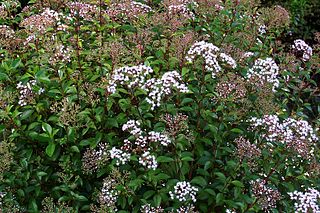
Eupatorium is a genus of flowering plants in the family Asteraceae, containing from 36 to 60 species depending on the classification system. Most are herbaceous perennials growing to 0.5–3 m (1.6–9.8 ft) tall. A few are shrubs. The genus is native to temperate regions of the Northern Hemisphere. Most are commonly called bonesets, thoroughworts or snakeroots in North America. The genus is named for Mithridates Eupator, king of Pontus.

Flavonols are a class of flavonoids that have the 3-hydroxyflavone backbone. Their diversity stems from the different positions of the phenolic -OH groups. They are distinct from flavanols such as catechin, another class of flavonoids.

Eupatorium perfoliatum, known as common boneset or just boneset, is a North American perennial plant in the family Asteraceae. It is a common native to the Eastern United States and Canada, widespread from Nova Scotia to Florida, west as far as Texas, Nebraska, the Dakotas, and Manitoba. It is also called agueweed, feverwort, or sweating-plant. It was introduced to American colonists by natives who used the plant for breaking fevers by means of heavy sweating. It is nearly always found in low, wet areas.
The molecular formula C21H20O11 (molar mass: 448.38 g/mol, exact mass: 448.100561 u) may refer to:
The molecular formula C21H20O10 (molar mass: 432.38 g/mol, exact mass: 432.105647 u) may refer to:

Myricitrin is a plant compound, the 3-O-α-L-rhamnopyranoside of myricetin.

The flavanonols are a class of flavonoids that use the 3-hydroxy-2,3-dihydro-2-phenylchromen-4-one backbone.

Smitilbin is a flavanonol, a type of flavonoid. It is a rhamnoside that can be isolated in Smilax glabra.

Azaleatin is a chemical compound. It is an O-methylated flavonol, a type of flavonoid. It was first isolated from the flowers of Rhododendron mucronatum in 1956 and has since been recorded in forty-four other Rhododendron species, in Plumbago capensis, in Ceratostigma willmottiana and in Carya pecan. It has been also been found in the leaves of Eucryphia.

Azalein is a chemical compound. It is a flavonol, a type of flavonoid. It is the 3-O-α-L-rhamnoside of azaleatin. It can be found in the flowers of Plumbago and Rhododendron species.
The molecular formula C23H24O12 (exact mass: 492.12677623) may refer to:

Eupatolitin is a chemical compound. It is an O-methylated flavonol, a type of flavonoid. Eupatolitin can be found in Brickellia veronicaefolia and in Ipomopsis aggregata.

Herbacetin is a flavonol, a type of flavonoid.

Syringetin is an O-methylated flavonol, a type of flavonoid. It is found in red grape, in Lysimachia congestiflora and in Vaccinium uliginosum. It is one of the phenolic compounds present in wine.

Eupalitin is an O-methylated flavonol. It can be found in Ipomopsis aggregata.

Eupalin is a flavonol. It is the eupalitin 3-O-rhamnoside. It can be isolated from Eupatorium ligustrinum.

Ageratina ligustrina, the (privet-leaved ageratina or privet-leaved snakeroot, is Mesoamerican species of evergreen flowering shrub in the sunflower family. It is widespread across much of Mexico and Central America from Tamaulipas to Costa Rica.

Smilax glabra, sarsaparilla, is a plant species in the genus Smilax. It is native to China, the Himalayas, and Indochina.

Dryopteris crassirhizoma is a fern species in the wood fern family Dryopteridaceae.

Afzelin is a flavonol glycoside. It is the rhamnoside of kaempferol. It is found in Nymphaea odorata.

















